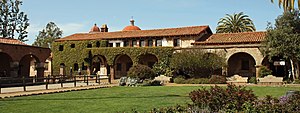
Back Missió de San Juan Capistrano Catalan Misión San Juan Capistrano Spanish Mission San Juan Capistrano French 圣胡安卡皮斯特拉诺传道院 Chinese
Mission San Juan Capistrano | |
| Location | 26801 Ortega Hwy. San Juan Capistrano, California 92675 |
|---|---|
| Coordinates | 33°30′10″N 117°39′46″W / 33.50278°N 117.66278°W |
| Name as founded | La Misión de San Juan Capistrano de Sajavit[1] |
| English translation | The Mission of Saint John Capistrano of Sajavit |
| Patron | Saint John of Capestrano[2] |
| Nickname(s) | "Jewel of the Missions"[3] "Mission of the Swallow"[4] "Mission of the Tragedies"[5] |
| Founding date | November 1, 1776[1] it was the 7th mission. |
| Founding priest(s) | Fermín Lasuén (1st)[6] Father Presidente Junípero Serra and Gregório Amúrrio (2nd)[7] |
| Founding Order | Seventh[2] |
| Military district | First[8][9] |
| Native tribe(s) Spanish name(s) | Acjachemen Juaneño |
| Native place name(s) | Quanís Savit, Sajavit[10] |
| Baptisms | 4,340[11] |
| Confirmations | 1,182[12] |
| Marriages | 1,153[11] |
| Burials | 3,126[11] |
| Neophyte population | 900[11][13] |
| Secularized | 1833[2] |
| Returned to the Church | 1865[2] |
| Governing body | Roman Catholic Diocese of Orange |
| Current use | Chapel / Museum |
| Designated | September 3, 1971 |
| Reference no. | 71000170 |
| Reference no. | #200 |
| Website | |
| http://www.missionsjc.com | |
Mission San Juan Capistrano (Spanish: Misión San Juan Capistrano) is a Spanish mission in San Juan Capistrano, Orange County, California. Founded November 1, 1776 in colonial Las Californias by Spanish Catholic missionaries of the Franciscan Order, it was named for Saint John of Capistrano. The Spanish Colonial Baroque style church was located in the Alta California province of the Viceroyalty of New Spain. The Mission was founded less than 60 yards from the village of Acjacheme.[14][15] The Mission was secularized by the Mexican government in 1833, and returned to the Roman Catholic Church by the United States government in 1865. The Mission was damaged over the years by a number of natural disasters, but restoration and renovation efforts date from around 1910. It functions today as a museum.
- ^ a b Leffingwell, p. 37
- ^ a b c d Krell, p. 153
- ^ Young, p. 26
- ^ Cite error: The named reference
missionplaywas invoked but never defined (see the help page). - ^ Ryan, p. 11
- ^ Cite error: The named reference
engelhardt6was invoked but never defined (see the help page). - ^ Engelhardt 1922, p.
- ^ Forbes, p. 202
- ^ Engelhardt 1920, pp. v, 228: "The military district of San Diego embraced the Missions of San Diego, San Luis Rey, San Juan Capistrano, and San Gabriel ..."
- ^ Ruscin, p. 195
- ^ a b c d Krell, p. 315: as of December 31, 1832; information adapted from Engelhardt's Missions and Missionaries of California.
- ^ Engelhardt 1922, pp. 175–176
- ^ Engelhardt 1922, pp. 175–176. 1812 saw the greatest number of neophytes attached to the Mission (1,361), whereas the smallest recorded neophyte population (383) was seen in 1783.
- ^ O'Neil, Stephen; Evans, Nancy H. (1980). "Notes on Historical Juaneno Villages and Geographical Features". UC Merced Journal of California and Great Basin Anthropology. 2 (2): 226–232.
- ^ Woodward, Lisa Louise (2007). The Acjachemen of San Juan Capistrano: The History, Language and Politics of an Indigenous California Community. University of California, Davis. pp. 3, 8.




